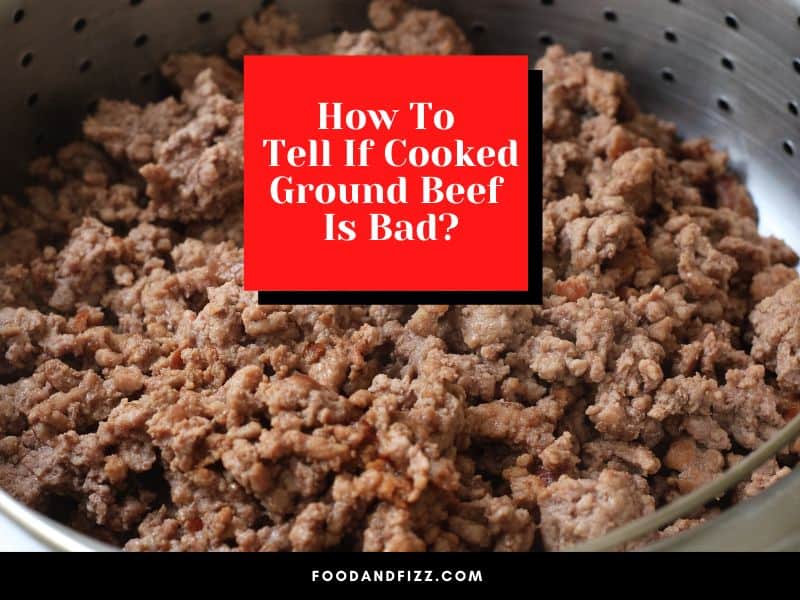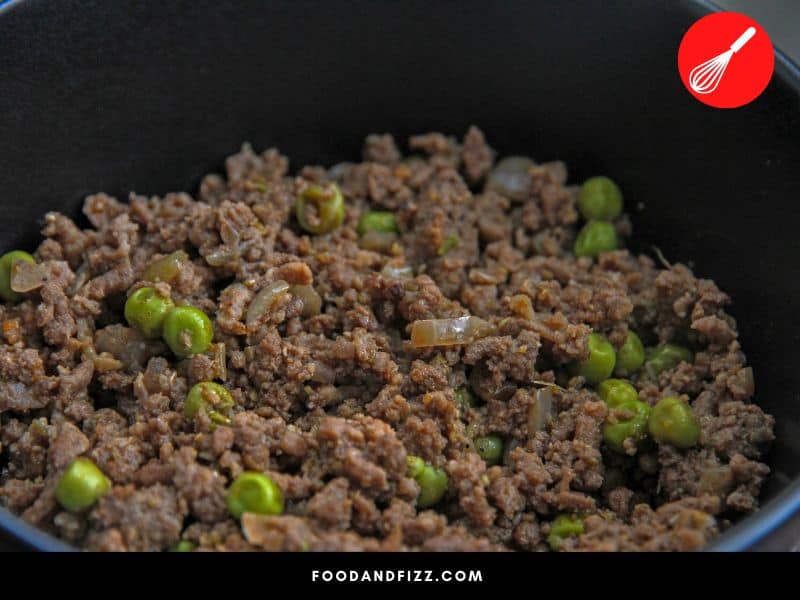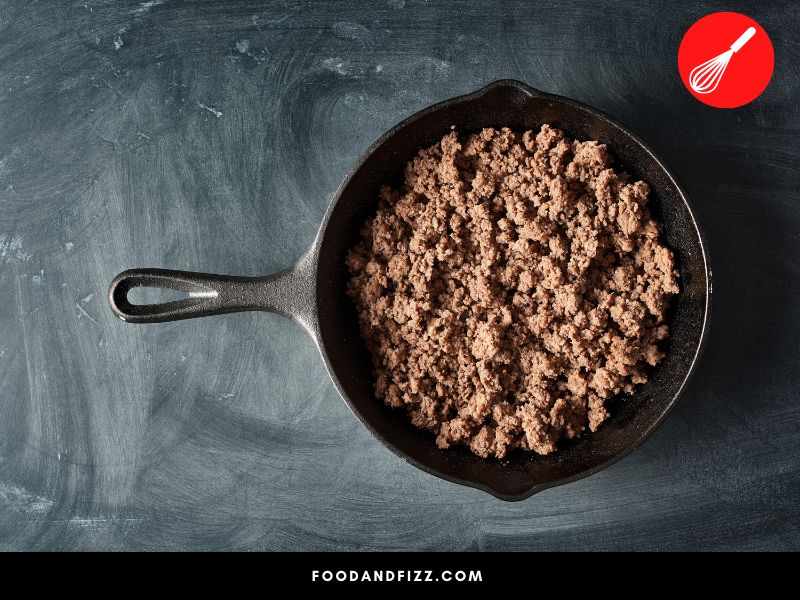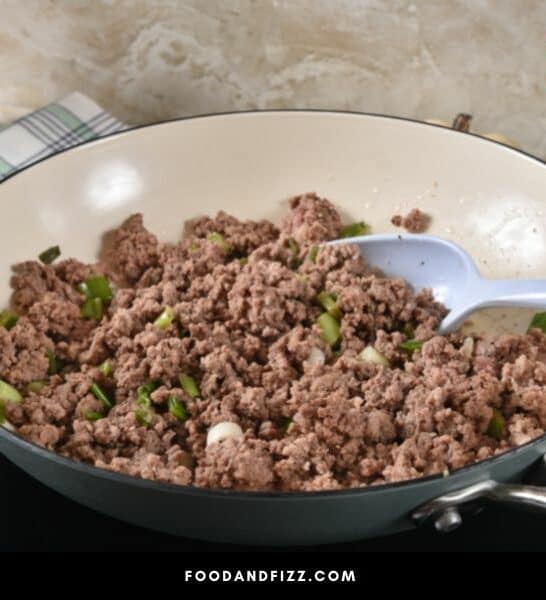Leftovers can both be a blessing and a curse. On one hand, it can save you from more hours of slaving away in the kitchen, and you can have several instantly available meals.
On the other hand, especially if you have a ton of leftovers, it can be challenging to finish it before it goes bad.
So how do you know if you can still use that leftover cooked ground beef?
How To Tell if Cooked Ground Beef Is Bad?
Cooked ground beef is ba if it has turned gray or green or any other unusual color, has developed mold or suspicious growths, has a strong pungent odor, or has developed a slimy or sticky texture. If it has been left out at room temperature for more than 2 hours or if it has been sitting in the fridge for more than 3-4 days, it is also best to discard it.

How Do I Know If Cooked Ground Beef Has Gone Bad?
Food generally tastes best when it is freshly cooked, and the more time that passes from the time you cook it, the more that the flavor deteriorates, and the more that bacteria can operate and cause it to spoil.
Cooked ground beef goes bad just like raw ground beef. Cooking does not protect it from bacteria that cause food spoilage but it does help prolong its shelf life for another day or two.
So how do you know if that cooked ground beef is still okay to consume? We’ve summarized all you need to know below.
1. Check what it looks like
When ground beef is cooked, it naturally turns brown. Depending on how long you cooked it initially, this shade of brown can vary.
As a general rule, its color should appear similar to how it was when it was just freshly cooked. It can be a light brown or a darker shade of brown and even have tinges of pink. As long it was cooked to a safe internal temperature initially, a mix of brown and pink colors should be okay.
If your cooked ground beef has turned a shade of gray, green or any other unusual color, or you noticed that there are fuzzy growths or some type of mold on the surface, it is a very clear sign that you should get rid of it.
White spots on cooked ground beef though, can be a little tricky. Sometimes, depending on the fat content of our ground beef, fat can appear as white spots on the beef when it is stored in the fridge.
Beef fat solidifies at lower temperatures, so if you notice that your ground beef has these spots, it may not necessarily mean that it has gone bad, but proceed with caution and check for other signs of spoilage.

2. Smell the beef
Our sense of smell is a pretty useful tool to use when checking if food is still good to eat. In general, our bodies gravitate to pleasant-smelling things because one, we equate pleasant-smelling things to pleasant-tasting food, and two, pleasant smells indicate to us that nothing is wrong and that it is perfectly safe to eat.
I understand the flaw and danger of the statement because of course that isn’t always the case—food that smells good isn’t always good, and food that smells bad isn’t always unsafe (think delicious stinky cheese!), however, this is how our sense of smell has evolved, and despite it not being a foolproof method, it has proven to be useful.
So on to our cooked ground beef. Smell your ground beef and see if it still smells like when you first cooked it.
It should smell of beef and of the spices or ingredients that you used in it. If it has a strange or a different smell, and if it has developed an unpleasant odor, then my advice is to toss it.
A pungent odor that smells like something died or that smells of rotten eggs is never a good indication of freshness. If you smell something akin to ammonia, or smell something metallic, you should also just throw it out.
Any unnatural smell that isn’t beef or isn’t an ingredient you used is a sign that bacteria has started to work on your ground beef.
3. Feel your ground beef
I know it isn’t always best practice to touch your food to check if it is still good but in this case, it is pretty important. Your cooked ground beef should not feel sticky or slimy, and should not have an unusual film coating it or covering it.
Instead, the texture should be firm or flaky, meaning, it doesn’t clump together. If your ground beef does not have the correct texture, the safest bet is to just throw it out.
4. Check that it has not been left out for more than 2 hours
Food safety rules stress that any type of food, raw or cooked, should not be allowed to remain at room temperature, or any temperature within the food danger zone, for more than 2 hours. The temperature range between 40°F- 140°F is this food danger zone.
In this temperature range, harmful bacteria become very active and can rapidly cause your food to decay or spoil. It is said that they can reproduce at a rapid rate, doubling in number in as little as 20 minutes.
This is why food safety authorities like the USDA and CDC state that we must never expose food to such temperatures for more than 2 hours, or 1 hour if we live in a very warm place.
Below 40°F and above 140 °F, these pathogens are neutralized, so it is advisable to transfer food to cold storage before this time period is up.
If you know that you left your ground beef out in these temperatures for more than 2 hours, or worse, overnight, then I would advise against consuming it since it has already been exposed to harmful pathogens.
Even if you don’t see any change in the meat yet, it is no guarantee that there is nothing going on beyond what our eyes can see. I say just toss it to be on the safe side.
To avoid this predicament, make sure to always properly store cooked food.

5. Make sure you consume your cooked ground beef within 3-4 days
According to the USDA, cooked ground beef will be good to eat for 3-4 days when you properly store it in the fridge. As long as there are no other signs that it has gone off, you should be good to go within this time frame.
Beyond this is where it will get a little tricky. Some people maintain that it can last longer especially if you have properly stored it, however, I personally think we should go with what the food safety authorities say.
Even if we don’t see anything growing on the ground beef or even if it smells fine and doesn’t look old, we have no way of knowing what is going on beyond what we can see.
Refrigerating your cooked ground beef does not make it immune from pathogens and bacteria. It merely slows down the process, but the inevitable will still come.
If you discover ground beef that has been lurking in the fridge since last week, it is best not to risk it and just toss it out.
If you truly want to store your cooked ground beef for longer, storing in the freezer will buy you more time than your refrigerator ever could. Cooked ground beef, or any food for that matter, will technically be safe to consume almost indefinitely when frozen, but of course, the freezer can also deteriorate its quality. It will be safe, but it will not necessarily be good.
According to the USDA, ground beef will generally retain its best quality within 4 months in the freezer, again, as long as it is properly stored.
I Ate Spoiled Ground Beef. What Should I Do?
Eating bad or spoiled ground beef can lead to a food-borne illness. Food-borne illnesses result from consumption of spoiled, contaminated or undercooked food.
Also called Food Poisoning, this condition manifests from a few hours to a few days after eating the questionable food, and can clear away on its own in a few hours or may persist for days or weeks.
Food poisoning symptoms usually include:
- Nausea
- Diarrhea
- Vomiting
- Headaches
- Stomach cramps
- Gastrointestinal discomfort
- Body aches and pains
- Fever
- Dizziness
- General feeling of weakness
Depending on the seriousness of the condition, symptoms may clear away right away or persist for a long time and may require hospitalization, depending on the person and situation. According to Cleveland Clinic, the average time that foodborne illnesses clear up is 24-48 hours.
Usually though, resting at home and hydrating will help you recover with no issues.
Here are some tips to remember if you find yourself on the unfortunate end of a bout of food poisoning:
1. Hydrate with fluids
Make sure to hydrate and drink lots of water. Apart from water, you also need to drink fluids that can help restore lost electrolytes and salts due to persistent vomiting or diarrhea.
Sports drinks and things like ginger ale, broth or sodas that do not have caffeine like Sprite or 7Up can help restore lost sodium and sugar which can help you recover faster.

2. Rest
Make sure to rest and give your body enough time to recover. What most people don’t realize is when we are sick with something, most of the time, it isn’t the medicines or what we are taking that is making us better.
It is ultimately our bodies, with the aid of these medicines, that are healing us and fighting off the pathogens that make us sick. Resting and sleeping adequately allows our body more resources to fight off the infection.
3. BRAT Diet
If you are able to eat, eat foods that are easy on the stomach and easy to digest. Following the BRAT diet — bananas, rice, applesauce and toast—s a good start.
These types of food will not cause unnecessary stress on an already struggling and sick digestive system. Stay away from foods that are a little more distressing to the digestive system, such as greasy or spicy or fried food.
4. Seek medical attention
If you are experiencing very severe symptoms and are unable to keep anything down, even fluids, seek medical help. Dehydration is very serious and can be deadly, so it is important to seek help so that you can be properly hydrated with an IV or other medicines. Do not wait it out or power through it as it can become very serious quickly.
How to Prevent Food Poisoning
Most cases of food poisoning clear away within 24-48 hours but people who have experienced it will tell you that it’s no walk in the park. It is better to avoid this happening to us in the first place, even if most people do recover quickly.
According to the CDC, there are four basic steps to follow in ensuring food safety.
- Clean surfaces and utensils, and wash your hands regularly throughout the entire process of preparing food and eating.
- Separate meat that is already cooked from raw meat, and make sure to use separate containers, chopping boards and knives to avoid cross-contamination. Raw food can contaminate other food items so make sure to keep them away from cooked foods or foods that will not be cooked prior to eating.
- Cook food always up to the minimum safe internal temperature. Never partially cook and store as partially cooked meat still harbor pathogens and bacteria that cause illness. Using a food thermometer will make this process easier.
- Chill your cooked food immediately and do not let them hang out in the food danger zone for more than 2 hours, 1 hour in a warm environment. Food must always be kept in the refrigerator or the freezer.
Following these safety tips ensures that bacteria that cause food-borne illnesses are kept at bay.
SAFETY TIPS TO PREVENT FOOD POISONING
| SAFETY TIPS TO PREVENT FOOD POISONING | |
| 1. Clean | Always wash your hands before, during, and after food preparation, and prior to eating |
| Wash hands after handling raw meat, seafood and eggs | |
| Clean and sanitize all cutting boards, utensils and surfaces thoroughly after each use | |
| 2. Separate | Keep raw meat, poultry, seafood, shellfish, and eggs separate from food that will not be cooked prior to eating |
| Use separate cutting boards and utensils for raw food | |
| Avoid washing raw meat and eggs as it can spread germs | |
| 3. Cook | Always cook food thoroughly to safe internal temperatures: |
| Ground Beef: 160 °F | |
| Chicken and poultry: 165 °F | |
| Beef : 145 °F | |
| Pork : 145 °F | |
| Leftovers: 165 °F | |
| Use a food thermometer | |
| 5. Chill | Properly cool cooked food and then refrigerate promptly |
| Do not allow food to stay in the food danger zone for more than 2 hours | |
| Store leftovers in covered containers | |
| Discard cooked ground beef that has been kept for more than 3-4 days | |
| CDC |

Frequently Asked Questions to How To Tell if Cooked Ground Beef is Bad?
How Long is Cooked Ground Beef Good For?
Cooked ground beef is good for 3-4 days when stored properly inside the refrigerator.
How to Know if Ground Beef is Bad After Thawing?
Bacteria that cause food spoilage are cannot act when meat is frozen but once it is thawed, your beef is vulnerable again. If ground beef has strange growths or has discolored, if it smells bad and has a slimy or sticky texture, it means it is not good to eat anymore. Also check that your ground beef was not kept outside more for than a couple of hours. If it has, the chances are higher that it is not safe to eat anymore.
Conclusion to How to Tell if Cooked Ground Beef is Bad
Cooked ground beef is bad if it has discoloration or strange growths on the surface, if it has developed a bad odor and exhibits a slimy or sticky texture.
If it has been left outside for a more than 2 hours, in the food danger zone, and if it has been stored in the fridge for longer than 3-4 days, then its safety is compromised.

